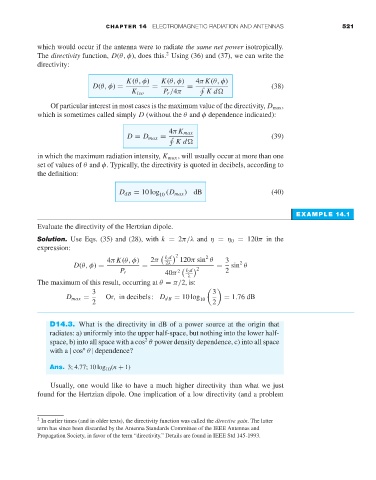Page 539 - Engineering Electromagnetics, 8th Edition
P. 539
CHAPTER 14 ELECTROMAGNETIC RADIATION AND ANTENNAS 521
which would occur if the antenna were to radiate the same net power isotropically.
2
The directivity function, D(θ, φ), does this. Using (36) and (37), we can write the
directivity:
K(θ, φ) K(θ, φ) 4π K(θ, φ)
D(θ, φ) = = =
(38)
K iso P r /4π Kd
Of particular interest in most cases is the maximum value of the directivity, D max ,
which is sometimes called simply D (without the θ and φ dependence indicated):
4π K max
(39)
D = D max =
Kd
in which the maximum radiation intensity, K max , will usually occur at more than one
set of values of θ and φ.Typically, the directivity is quoted in decibels, according to
the definition:
D dB = 10 log (D max ) dB (40)
10
EXAMPLE 14.1
Evaluate the directivity of the Hertzian dipole.
Solution. Use Eqs. (35) and (28), with k = 2π/λ and η = η 0 = 120π in the
expression:
2
4π K(θ, φ) 2π I 0 d 2 120π sin θ 3
2
D(θ, φ) = = 2λ = sin θ
P r 40π 2 I 0 d 2 2
λ
The maximum of this result, occurring at θ = π/2, is:
3
3
D max = Or, in decibels: D dB = 10 log 10 = 1.76 dB
2 2
D14.3. What is the directivity in dB of a power source at the origin that
radiates: a) uniformly into the upper half-space, but nothing into the lower half-
2
space, b) into all space with a cos θ power density dependence, c) into all space
n
with a | cos θ| dependence?
Ans. 3; 4.77; 10 log (n + 1)
10
Usually, one would like to have a much higher directivity than what we just
found for the Hertzian dipole. One implication of a low directivity (and a problem
2 In earlier times (and in older texts), the directivity function was called the directive gain. The latter
term has since been discarded by the Antenna Standards Committee of the IEEE Antennas and
Propagation Society, in favor of the term “directivity.” Details are found in IEEE Std 145-1993.

